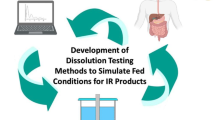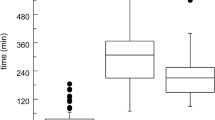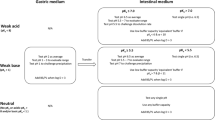Abstract
Purpose
The aim of this study was to update the compositions of biorelevant media to represent the composition and physical chemical characteristics of the gastrointestinal fluids as closely as possible while providing physical stability during dissolution runs and short-term storage.
Methods
Media were designed to reflect postprandial conditions in the stomach and proximal small intestine in the “early”, “middle”, and “late” phases of digestion. From these “snapshot” media, general media for simulating postprandial conditions were devised. Additionally, media reflecting preprandial conditions in the stomach and small intestine were revisited.
Results
A set of four media is presented. A recently published medium to represent the fasted stomach, FaSSGF, needed no further revision. To simulate the postprandial stomach, a new medium, FeSSGF, is presented. Media representing the upper small intestine in the fed and fasted states were fine-tuned according to physicochemical and biochemical characteristics in vivo. All four media proved to be stable under ambient storage conditions for at least 72 h as well as under usual dissolution test conditions.
Conclusions
The updated dissolution media can be used to predict formulation performance and food effects in vivo. These media are more physiologically relevant and show better physical stability than their corresponding predecessors.






Similar content being viewed by others
References
J. B. Dressman, G. L. Amidon, C. Reppas, and V. P. Shah. Dissolution testing as a prognostic tool for oral drug absorption: immediate release dosage forms. Pharm. Res. 15:11–22 (1998).
The United States Pharmacopeia. USP 29. United States Pharmacopeial Convention Inc., Rockville, MD (2006).
E. Galia, J. Horton, and J. B. Dressman. Albendazole generics—a comparative in vitro study. Pharm. Res. 16:1871–1875 (1999).
M. Vertzoni, E. Pastelli, D. Psachoulias, L. Kalantzi, and C. Reppas. Estimation of intragastric solubility of drugs: in what medium? Pharm. Res. 24:909–917 (2007).
M. Vertzoni, J. Dressman, J. Butler, J. Hempenstall, and C. Reppas. Simulation of fasting gastric conditions and its importance for the in vivo dissolution of lipophilic compounds. Eur. J. Pharm. Biopharm. 60:413–417 (2005).
J. Krämer. Korrelation biopharmazeutischer in vivo und in vitro Daten von Theophyllin und Verapamil Retardpräparaten. Doctoral thesis, Ruprecht-Karls-University, Heidelberg, Germany, 1995.
S. Klein, J. Butler, J. M. Hempenstall, C. Reppas, and J. B. Dressman. Media to simulate the postprandial stomach I. Matching the physicochemical characteristics of standard breakfasts. J. Pharm. Pharmacol. 56:605–610 (2004).
P. Macheras, M. Koupparis, and C. Tsaprounis. Drug dissolution studies in milk using the automated flow injection serial dynamic dialysis technique. Int. J. Pharm. 33:125–136 (1986).
P. E. Macheras, M. A. Koupparis, and S. G. Antimisiaris. Drug binding and solubility in milk. Pharm. Res. 7:537–541 (1990).
E. Galia, E. Nicolaides, D. Hörter, R. Löbenberg, C. Reppas, and J. B. Dressman. Evaluation of various dissolution media for predicting in vivo performance of class I and II drugs. Pharm. Res. 15:698–705 (1998).
E. Nicolaides, E. Galia, C. Efthymiopoulos, J. B. Dressman, and C. Reppas. Forecasting the in vivo performance of four low solubility drugs from their in vitro dissolution data. Pharm. Res. 16:1876–1882 (1999).
G. Buckton, A. E. Beezer, S. M. Chatham, and K. K. Patel. In vitro dissolution testing of oral controlled release preparations in the presence of artificial foodstuffs. II. Probing drug food interactions using microcalorimetry. Int. J. Pharm. 56:151–157 (1989).
P. E. Macheras, M. A. Koupparis, and S. G. Antimisiaris. Effect of temperature and fat content on the solubility of hydrochlorothiazide and chlorothiazide in milk. J. Pharm. Sci. 78:933–936 (1989).
P. E. Macheras, M. A. Koupparis, and S. G. Antimisiaris. Effect of temperature and fat content on the binding of hydrochlorothiazide and chlorothiazide to milk. J. Pharm. Sci. 77:334–336 (1988).
S. Anwar, J. T. Fell, and P. A. Dickinson. An investigation of the disintegration of tablets in biorelevant media. Int. J. Pharm. 290:121–127 (2005).
N. Fotaki, M. Symillides, and C. Reppas. Canine versus in vitro data for predicting input profiles of l-sulpiride after oral administration. Eur. J. Pharm. Sci. 26:324–333 (2005).
V. A. Gray, and J. B. Dressman. Change of pH requirements for simulated intestinal fluid TS. Pharmacop. Forum. 22:1943–1945 (1996).
J. B. Dressman, and C. Reppas. In vitro-in vivo correlations for lipophilic, poorly water-soluble drugs. Eur. J. Pharm. Sci. 11(2):S73–S80 (2000).
H. Wei, and R. Löbenberg. Biorelevant dissolution media as a predictive tool for glyburide a class II drug. Eur. J. Pharm. Sci. 29:45–52 (2006).
V. H. Sunesen, B. L. Pedersen, H. G. Kristensen, and A. Müllertz. In vivo in vitro correlations for a poorly soluble drug, danazol, using the flow-through dissolution method with biorelevant dissolution media. Eur. J. Pharm. Sci. 24:305–313 (2005).
J. Parojcic, Z. Ethuric, M. Jovanovic, S. Ibric, and D. Jovanovic. Influence of dissolution media composition on drug release and in vitro/in vivo correlation for paracetamol matrix tablets prepared with novel carbomer polymers. J. Pharm. Pharmacol. 56:735–741 (2004).
K. Schamp, S. A. Schreder, and J. Dressman. Development of an in vitro/in vivo correlation for lipid formulations of EMD 50733, a poorly soluble, lipophilic drug substance. Eur. J. Pharm. Biopharm. 62:227–234 (2006).
E. Nicolaides, M. Symillides, J. B. Dressman, and C. Reppas. Biorelevant dissolution testing to predict the plasma profile of lipophilic drugs after oral administration. Pharm. Res. 18:380–388 (2001).
M. Vertzoni, N. Fotaki, E. Kostewicz, E. Stippler, C. Leuner, E. Nicolaides, J. Dressman, and C. Reppas. Dissolution media simulating the intralumenal composition of the small intestine: physiological issues and practical aspects. J. Pharm. Pharmacol. 56:453–462 (2004).
L. Kalantzi, K. Goumas, V. Kalioras, B. Abrahamsson, J. B. Dressman, and C. Reppas. Characterization of the human upper gastrointestinal contents under conditions simulating bioavailability/bioequivalence studies. Pharm. Res. 23:165–176 (2006).
M. Grove, G. P. Pedersen, J. L. Nielsen, and A. Müllertz. Bioavailability of seocalcitol I: relating solubility in biorelevant media with oral bioavailability in rats-effect of medium and long chain triglycerides. J. Pharm. Sci. 94:1830–1838 (2005).
C. J. Porter, N. L. Trevaskis, and W. N. Charman. Lipids and lipid-based formulations: optimizing the oral delivery of lipophilic drugs. Nat. Rev. Drug Discov. 6:231–248 (2007).
A. G. Hills. pH and Henderson–Hasselbalch equation. Am. J. Med. 55:131–133 (1973).
D. D. Van Slyke. On the measurement of buffer values on the relationship of buffer values to the dissociation constant of the buffer and the concentration and reaction of the buffer solution. J. Biol. Chem. 52:525–570 (1922).
R. Dolder. Ophthalmika. Wissenschaftliche Velagsgesellschaft mbH Stuttgart (1990).
US FDA, US Department of Health and Human Services, Center for Drug Evaluation and Research, Guidance for Industry: Food-Effect Bioavailability and Fed Bioequivalence Studies, December 2002.
J. B. Dressman, R. R. Berardi, L. C. Dermentzoglou, T. L. Russell, S. P. Schmaltz, J. L. Barnett, and K. M. Jarvenpaa. Upper gastrointestinal (GI) pH in young, healthy men and women. Pharm. Res. 7:756–761 (1990).
T. L. Russell, R. R. Berardi, J. L. Barnett, L. C. Dermentzoglou, K. M. Jarvenpaa, S. P. Schmaltz, and J. B. Dressman. Upper gastrointestinal pH in seventy-nine healthy, elderly, North American men and women. Pharm. Res. 10:187–196 (1993).
L. Kalantzi, E. Persson, B. Polentarutti, B. Abrahamsson, K. Goumas, J. B. Dressman, and C. Reppas. Canine intestinal contents vs. simulated media for the assessment of solubility of two weak bases in the human small intestinal contents. Pharm. Res. 23:1373–1381 (2006).
A. Albert, and E. Sargent. Ionization constants of acids and bases (Russian translation). Khimiya, Moscow, p. 139, 1964.
H. P. Fiedler. Lexikon der Hilfsstoffe, OVR Oberschwäbische Verlagsanstalt Ravensburg. Ravensburg, Germany, 1989.
S. Budavari. The Merck index 12. Merck Research Laboratories, Whitehouse Station, NJ, 1996.
J. Pellicer, V. García-Morales, and M. J. Hernández. On the demonstration of the Young–Laplace equation in introductory physics courses. Phys. Educ. 35:126–129 (2000).
E. Galia. Physiologically based dissolution tests. Doctoral thesis, Johann Wolfgang Goethe University, Frankfurt am Main, Germany, 1999.
K. J. MacGregor, J. K. Embleton, J. E. Lacy, E. A. Perry, L. J. Solomon, H. Seager, and C. W. Pouton. Influence of lipolysis on drug absorption from the gastro-intestinal tract. Adv. Drug Deliv. Rev. 25:33–46 (1997).
O. Hernell, J. E. Staggers, and M. C. Carey. Physical-chemical behavior of dietary and biliary lipids during intestinal digestion and absorption. 2. Phase analysis and aggregation states of luminal lipids during duodenal fat digestion in healthy adult human beings. Biochemistry. 29:2041–2056 (1990).
P. E. Luner. Wetting properties of bile salt solutions and dissolution media. J. Pharm. Sci. 89:382–395 (2000).
E. Jantratid, N. Janssen, H. Chokshi, K. Tang, and J. B. Dressman. Designing biorelevant dissolution tests for lipid formulations: case example—lipid suspension of RZ-50. Eur. J. Pharm. Biopharm. in press (2008), DOI 10.1016/j.ejpb.2007.12.010.
J. J. Sheng, N. A. Kasim, R. Chandrasekharan, and G. L. Amidon. Solubilization and dissolution of insoluble weak acid, ketoprofen: effects of pH combined with surfactant. Eur. J. Pharm. Sci. 29:306–314 (2006).
J. Jinno, D. Oh, J. R. Crison, and G. L. Amidon. Dissolution of ionizable water-insoluble drugs: the combined effect of pH and surfactant. J. Pharm. Sci. 89:268–274 (2000).
S. Li, S. Wong, S. Sethia, H. Almoazen, Y. M. Joshi, and A. T. Serajuddin. Investigation of solubility and dissolution of a free base and two different salt forms as a function of pH. Pharm. Res. 22:628–635 (2005).
C. Wu, and J. W. McGinity. Influence of an enteric polymer on drug release rates of theophylline from pellets coated with Eudragit RS 30D. Pharm. Dev. Technol. 8:103–110 (2003).
E. T. Cole, R. A. Scott, A. L. Connor, I. R. Wilding, H. U. Petereit, C. Schminke, T. Beckert, and D. Cade. Enteric coated HPMC capsules designed to achieve intestinal targeting. Int. J. Pharm. 231:83–95 (2002).
O. S. Silva, C. R. Souza, W. P. Oliveira, and S. C. Rocha. In vitro dissolution studies of sodium diclofenac granules coated with Eudragit L-30D-55 by fluidized-bed system. Drug Dev. Ind. Pharm. 32:661–667 (2006).
A. Trapani, V. Laquintana, N. Denora, A. Lopedota, A. Cutrignelli, M. Franco, G. Trapani, and G. Liso. Eudragit RS 100 microparticles containing 2-hydroxypropyl-beta-cyclodextrin and glutathione: physicochemical characterization, drug release and transport studies. Eur. J. Pharm. Sci. 30:64–74 (2007).
T. Phaechamud, and G. C. Ritthidej. Sustained-release from layered matrix system comprising chitosan and xanthan gum. Drug Dev. Ind. Pharm. 33:595–605 (2007).
K. G. Mooney, M. A. Mintun, K. J. Himmelstein, and V. J. Stella. Dissolution kinetics of carboxylic acids I: effect of pH under unbuffered conditions. J. Pharm. Sci. 70:13–22 (1981).
K. G. Mooney, M. A. Mintun, K. J. Himmelstein, and V. J. Stella. Dissolution kinetics of carboxylic acids II: effect of buffers. J. Pharm. Sci. 70:22–32 (1981).
S. S. Ozturk, B. O. Palsson, B. Donohoe, and J. B. Dressman. Kinetics of release from enteric-coated tablets. Pharm. Res. 5:550–565 (1988).
C. J. Porter, and W. N. Charman. In vitro assessment of oral lipid based formulations. Adv. Drug Deliv. Rev. 50(1):S127–S147 (2001).
J. E. Boni, R. S. Brickl, and J. Dressman. Is bicarbonate buffer suitable as a dissolution medium? J. Pharm. Pharmacol. 59:1375–1382 (2007).
P. G. Welling. Effects of food on drug absorption. Annu. Rev. Nutr. 16:383–415 (1996).
J. M. Custodio, C.-Y. Wu, and L. Z. Benet. Predicting drug disposition, absorption/elimination/transporter interplay and the role of food on drug absorption. Adv. Drug Deliv. Rev. 60:717–733 (2008).
S. Li, P. Doyle, S. Metz, A. E. Royce, and A. T. Serajuddin. Effect of chloride ion on dissolution of different salt forms of haloperidol, a model basic drug. J. Pharm. Sci. 94:2224–2231 (2005).
R. Bodmeier, X. Guo, R. E. Sarabia, and P. F. Skultety. The influence of buffer species and strength on diltiazem HCl release from beads coated with the aqueous cationic polymer dispersions, Eudragit RS, RL 30D. Pharm. Res. 13:52–56 (1996).
K. Knop. Influence of buffer solution composition on drug release from pellets coated with neutral and quaternary acrylic polymers and on swelling of free polymer films. Eur. J. Pharm. Sci. 4:293–300 (1996).
M. W. Rudolph, S. Klein, T. E. Beckert, H. Petereit, and J. B. Dressman. A new 5-aminosalicylic acid multi-unit dosage form for the therapy of ulcerative colitis. Eur. J. Pharm. Biopharm. 51:183–190 (2001).
M. C. Bonferoni, S. Rossi, F. Ferrari, E. Stavik, A. Pena-Romero, and C. Caramella. Factorial analysis of the influence of dissolution medium on drug release from carrageenan–diltiazem complexes. AAPS PharmSciTech. 1:E15 (2000).
E. S. Kostewicz, U. Brauns, R. Becker, and J. B. Dressman. Forecasting the oral absorption behavior of poorly soluble weak bases using solubility and dissolution studies in biorelevant media. Pharm. Res. 19:345–349 (2002).
X. Cai, D. J. Grant, and T. S. Wiedmann. Analysis of the solubilization of steroids by bile salt micelles. J. Pharm. Sci. 86:372–377 (1997).
S. D. Mithani, V. Bakatselou, C. N. TenHoor, and J. B. Dressman. Estimation of the increase in solubility of drugs as a function of bile salt concentration. Pharm. Res. 13:163–167 (1996).
M. Rosoff, and A. T. M. Serajuddin. Solubilization of diazepam in bile-salts and in sodium cholate–lecithin–water phases. Int. J. Pharm. 6:137–146 (1980).
H. M. Jones, N. Parrott, G. Ohlenbusch, and T. Lave. Predicting pharmacokinetic food effects using biorelevant solubility media and physiologically based modelling. Clin. Pharmacokinet. 45:1213–1226 (2006).
P. E. Luner, and D. Vander Kamp. Wetting behavior of bile salt-lipid dispersions and dissolution media patterned after intestinal fluids. J. Pharm. Sci. 90:348–359 (2001).
P. E. Luner, and D. VanDer Kamp. Wetting characteristics of media emulating gastric fluids. Int. J. Pharm. 212:81–91 (2001).
D. Fleisher, C. Li, Y. Zhou, L. H. Pao, and A. Karim. Drug, meal and formulation interactions influencing drug absorption after oral administration. Clinical implications. Clin. Pharmacokinet. 36:233–254 (1999).
W. N. Charman, C. J. Porter, S. Mithani, and J. B. Dressman. Physicochemical and physiological mechanisms for the effects of food on drug absorption: the role of lipids and pH. J. Pharm. Sci. 86:269–282 (1997).
M. Armand, P. Borel, B. Pasquier, C. Dubois, M. Senft, M. Andre, J. Peyrot, J. Salducci, and D. Lairon. Physicochemical characteristics of emulsions during fat digestion in human stomach and duodenum. Am. J. Physiol. 271:G172–G183 (1996).
M. Armand, B. Pasquier, M. Andre, P. Borel, M. Senft, J. Peyrot, J. Salducci, H. Portugal, V. Jaussan, and D. Lairon. Digestion and absorption of 2 fat emulsions with different droplet sizes in the human digestive tract. Am. J. Clin. Nutr. 70:1096–1106 (1999).
M. Armand. Lipases and lipolysis in the human digestive tract: where do we stand? Curr. Opin. Clin. Nutr. Metab. Care. 10:156–164 (2007).
K. Gyr, N. M. Agrawal, O. Felsenfeld, and R. G. Font. Comparative study of secretin and Lundh tests. Am. J. Dig. Dis. 20:506–512 (1975).
B. Lurie, B. Brom, S. Bank, B. Novis, and I. N. Marks. Comparative response of exocrine pancreatic secretion following a test meal and secretin-pancreozymin stimulation. Scand. J. Gastroenterol. 8:27–32 (1973).
F. Carriere, C. Renou, V. Lopez, J. De Caro, F. Ferrato, H. Lengsfeld, A. De Caro, R. Laugier, and R. Verger. The specific activities of human digestive lipases measured from the in vivo and in vitro lipolysis of test meals. Gastroenterology. 119:949–960 (2000).
C. W. Pouton. Formulation of poorly water-soluble drugs for oral administration: physicochemical and physiological issues and the lipid formulation classification system. Eur. J. Pharm. Sci. 29:278–287 (2006).
N. H. Zangenberg, A. Müllertz, H. G. Kristensen, and L. Hovgaard. A dynamic in vitro lipolysis model. I. Controlling the rate of lipolysis by continuous addition of calcium. Eur. J. Pharm. Sci. 14:115–122 (2001).
N. H. Zangenberg, A. Müllertz, H. G. Kristensen, and L. Hovgaard. A dynamic in vitro lipolysis model. II: Evaluation of the model. Eur. J. Pharm. Sci. 14:237–244 (2001).
A. M. Kaukonen, B. J. Boyd, C. J. Porter, and W. N. Charman. Drug solubilization behavior during in vitro digestion of simple triglyceride lipid solution formulations. Pharm. Res. 21:245–253 (2004).
A. M. Kaukonen, B. J. Boyd, W. N. Charman, and C. J. Porter. Drug solubilization behavior during in vitro digestion of suspension formulations of poorly water-soluble drugs in triglyceride lipids. Pharm. Res. 21:254–260 (2004).
Author information
Authors and Affiliations
Corresponding author
Rights and permissions
About this article
Cite this article
Jantratid, E., Janssen, N., Reppas, C. et al. Dissolution Media Simulating Conditions in the Proximal Human Gastrointestinal Tract: An Update. Pharm Res 25, 1663–1676 (2008). https://doi.org/10.1007/s11095-008-9569-4
Received:
Accepted:
Published:
Issue Date:
DOI: https://doi.org/10.1007/s11095-008-9569-4




